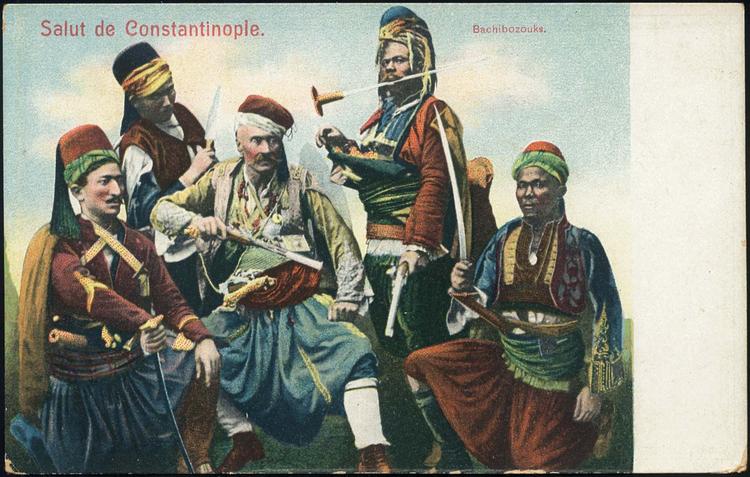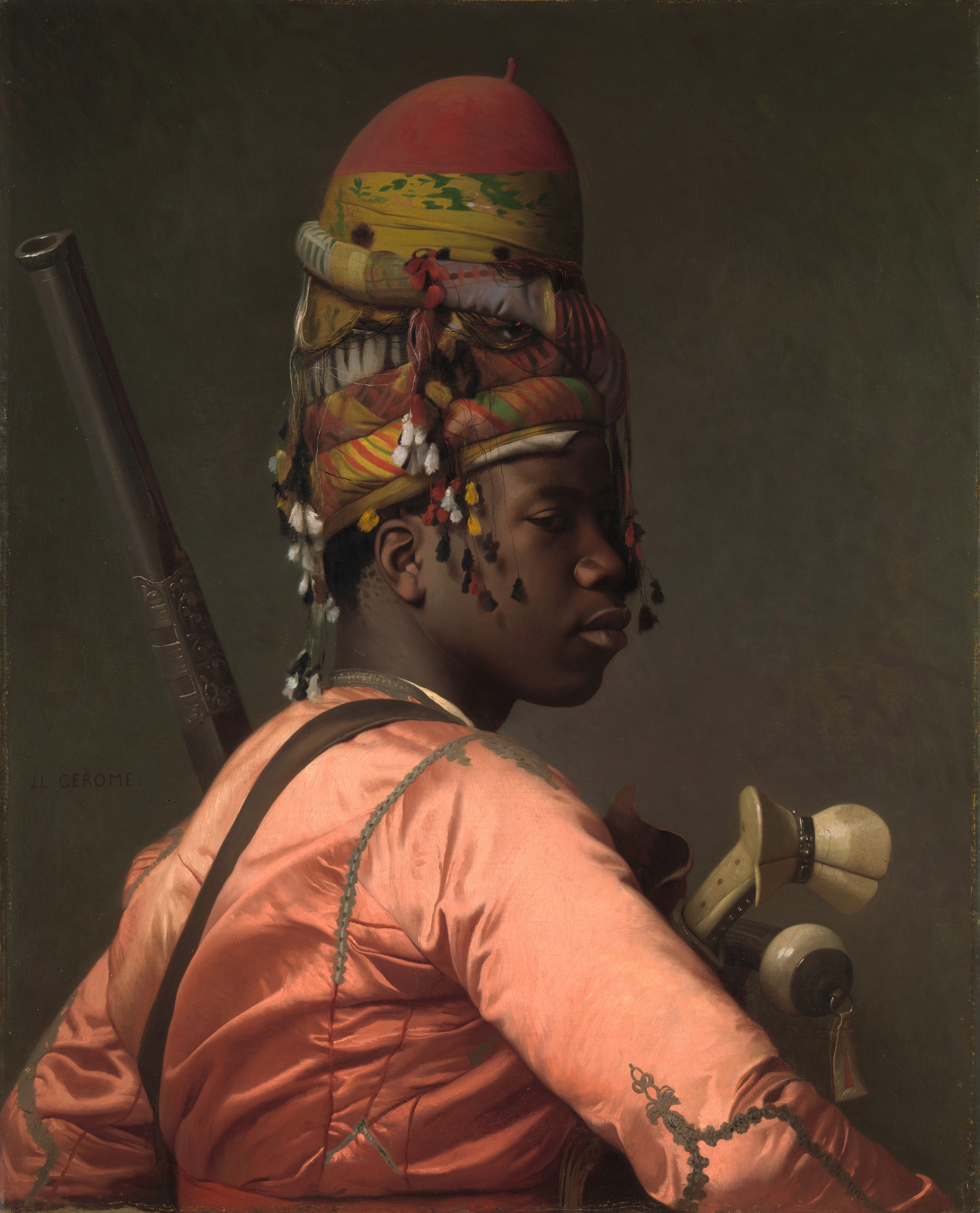Bashibozouk on:
[Wikipedia]
[Google]
[Amazon]

 A bashi-bazouk ( ota, ØĻاØīÛ ØĻŲØēŲŲ , , , roughly "leaderless" or "disorderly") was an irregular soldier of the Ottoman army, raised in times of war. The army chiefly recruited
A bashi-bazouk ( ota, ØĻاØīÛ ØĻŲØēŲŲ , , , roughly "leaderless" or "disorderly") was an irregular soldier of the Ottoman army, raised in times of war. The army chiefly recruited
File:ÐÐļÐūŅŅÐūÐēŅКÐļÐđ. ÐąÐ°ŅаКŅКаŅ ŅÐĩÐ·Ð―Ņ. 1889 ÐģÐūÐī.jpeg, Bashi-bazouks carrying out the Batak massacre.
File:Basibozuk-1877.jpg, Bashi-bazouks' atrocities in Ottoman Bulgaria.
File:Konstantin Makovsky - The Bulgarian martyresses.jpg, ''The Bulgarian Martyresses'' (1877), painting by
File:Chef arnaute by Jean-LÃĐon GÃĐrÃīme.jpg, An Albanian bashi-bazouk in Egypt. Painting by Jean-LÃĐon GÃĐrÃīme, 1870.
File:A Bashi-Bazouk, drawn by Francis Davis Millet.jpg, Drawing of a bashi-bazouk by Francis Davis Millet, 1889.
File:Jean-LÃĐon GÃĐrÃīme â Bachi-bouzouk Arnaoute.jpg, An Albanian bashi-bazouk painted by Jean-LÃĐon GÃĐrÃīme in the 1860s.
File:Vernet-Lecomte 7.jpg, A bashi-bazouk contemplating his loot. Painting by

 A bashi-bazouk ( ota, ØĻاØīÛ ØĻŲØēŲŲ , , , roughly "leaderless" or "disorderly") was an irregular soldier of the Ottoman army, raised in times of war. The army chiefly recruited
A bashi-bazouk ( ota, ØĻاØīÛ ØĻŲØēŲŲ , , , roughly "leaderless" or "disorderly") was an irregular soldier of the Ottoman army, raised in times of war. The army chiefly recruited Albanians
The Albanians (; sq, ShqiptarÃŦt ) are an ethnic group and nation native to the Balkan Peninsula who share a common Albanian ancestry, culture, history and language. They primarily live in Albania, Kosovo, North Macedonia, Montenegro, Se ...
and Circassians
The Circassians (also referred to as Cherkess or Adyghe; Adyghe and Kabardian: ÐÐīŅÐģŅŅ
ŅŅ, romanized: ''AdÄągÉxÉr'') are an indigenous Northwest Caucasian ethnic group and nation native to the historical country-region of Circassia in ...
as bashi-bazouks, but recruits came from all ethnic groups of the Ottoman Empire
The Ottoman Empire, * ; is an archaic version. The definite article forms and were synonymous * and el, ÐÎļÏÎžÎąÎ―ÎđΚÎŪ ÎÏ
ÏÎŋΚÏÎąÏÎŋÏÎŊÎą, OthÅmanikÄ Avtokratoria, label=none * info page on book at Martin Luther University) ...
including slaves from Europe
Europe is a large peninsula conventionally considered a continent in its own right because of its great physical size and the weight of its history and traditions. Europe is also considered a Continent#Subcontinents, subcontinent of Eurasia ...
or Africa
Africa is the world's second-largest and second-most populous continent, after Asia in both cases. At about 30.3 million km2 (11.7 million square miles) including adjacent islands, it covers 6% of Earth's total surface area ...
. They had a reputation for bravery, but also as an undisciplined and brutal group, notorious for looting and preying on civilians as a result of a lack of regulation and of the expectation that they would support themselves off the land.
Origin and history
Although the Ottoman armies always contained mercenaries as well as regular soldiers, the strain on the Ottomanfeudal system
Feudalism, also known as the feudal system, was the combination of the legal, economic, military, cultural and political customs that flourished in medieval Europe between the 9th and 15th centuries. Broadly defined, it was a way of structur ...
caused mainly by the Empire's wide expanse required heavier reliance on irregular soldiers. They were armed and maintained by the government, but did not receive pay and did not wear uniforms or distinctive badges. They were motivated to fight mostly by expectations of plunder
Looting is the act of stealing, or the taking of goods by force, typically in the midst of a military, political, or other social crisis, such as war, natural disasters (where law and civil enforcement are temporarily ineffective), or rioting. ...
. Though the majority of troops fought on foot, some troops (called '' aáļģÄąncÄą'') rode on horseback. Because of their lack of discipline, they were incapable of undertaking major military operations, but were useful for other tasks such as reconnaissance and outpost duty. However, their uncertain temper occasionally made it necessary for the Ottoman regular troops to disarm them by force.
The Ottoman army consisted of the following:
* The Sultan's household troops, called ''KapÄąkulu
''KapÄąkulu'' ( ota, ŲŲūŲŲŲŲŲ اŲ؎اؚÛ, ''KapÄąkulu OcaÄÄą'', "Slaves of the Sublime Porte") was the collective name for the Household Division of the Ottoman Sultans. They included the Janissary infantry corps as well as the Six Divis ...
'', which were salaried, most notable being Janissary corps.
* Provincial soldiers, which were fiefed (Turkish '' TÄąmarlÄą''), the most important being ''Timarli Sipahi'' (lit. "fiefed cavalry") and their retainers (called ''cebelu'' lit. armed, man-at-arms), but other kinds were also present
* Soldiers of subject, protectorate, or allied states (the most important being the Crimea
Crimea, crh, ÐŅŅŅŅО, QÄąrÄąm, grc, ÎÎđΞΞÎĩÏÎŊÎą / ÎĪÎąÏ
ÏÎđΚÎŪ, translit=KimmerÃa / Taurikáļ ( ) is a peninsula in Ukraine, on the northern coast of the Black Sea, that has been occupied by Russia since 2014. It has a pop ...
n Khans)
* Bashi-bazouks, who usually did not receive regular salaries and lived off loot
Many Afro-Turks
Afro-Turks ( tr, AfrikalÄą TÞrkler) are Turkish people of African Zanj (Bantu) descent, who trace their origin to the Ottoman slave trade like the Afro-Abkhazians. Afro-Turk population is estimated to be between 5,000 and 20,000 people. Afro ...
, Crimean Tatars, Muslim Roma, and Pomaks were bashi-bazouks in Rumelia
Rumelia ( ota, ØąŲŲ
اŲŲŲ, Rum Ä°li; tr, Rumeli; el, ÎĄÏΞÏ
ÎŧÎŊÎą), etymologically "Land of the Names of the Greeks#Romans (áŋŽÏΞιáŋÎŋÎđ), Romans", at the time meaning Eastern Orthodox Christians and more specifically Christians f ...
.
An attempt by Koca HÞsrev Mehmed Pasha to disband his Albanian bashi-bazouks in favor of his regular forces began the rioting which led to the establishment of Muhammad Ali
Muhammad Ali (; born Cassius Marcellus Clay Jr.; January 17, 1942 â June 3, 2016) was an American professional boxer and activist. Nicknamed "The Greatest", he is regarded as one of the most significant sports figures of the 20th century, a ...
's Khedivate of Egypt
The Khedivate of Egypt ( or , ; ota, ØŪØŊÛŲÛØŠ Ų
ØĩØą ') was an autonomous tributary state of the Ottoman Empire, established and ruled by the Muhammad Ali Dynasty following the defeat and expulsion of Napoleon Bonaparte's forces which brou ...
. The use of bashi-bazouks was abandoned by the end of the 19th century. However, self-organized bashi-bazouk troops still appeared later.
The term "bashibozouk" has also been used for a mounted force, existing in peacetime in various provinces of the Ottoman Empire, which performed the duties of gendarmerie
Wrong info! -->
A gendarmerie () is a military force with law enforcement duties among the civilian population. The term ''gendarme'' () is derived from the medieval French expression ', which translates to " men-at-arms" (literally, ...
.
Reputation and atrocities
The bashi-bazouks were notorious for being violently brutal and undisciplined, thus giving the term its second, colloquial meaning of "undisciplined bandit" in many languages. A notable example of this use is in the comic series ''The Adventures of Tintin
''The Adventures of Tintin'' (french: Les Aventures de Tintin ) is a series of 24 bande dessinÃĐe#Formats, ''bande dessinÃĐe'' albums created by Belgians, Belgian cartoonist Georges Remi, who wrote under the pen name HergÃĐ. The series was one ...
'', where the word is often used as an insult by Captain Haddock
Captain Archibald Haddock (french: Capitaine Archibald Haddock, link=no, ) is a fictional character in ''The Adventures of Tintin'', the comics series by Belgian cartoonist HergÃĐ. He is one of Tintin's best friends, a seafaring pipe-smoking ...
.
The Batak massacre (1876) was carried out by thousands of bashi-bazouks sent to quell a local rebellion. Likewise, bashi-bazouks perpetrated the massacres of Candia and Phocaea in 1898 and 1914. During the 1903 Ilinden-Preobrazhenie Uprising in Ottoman Macedonia, these troops burned 119 villages and destroyed 8400 houses, and over 50,000 Bulgarian refugees fled into the mountains.
Konstantin Makovsky
Konstantin Yegorovich Makovsky (russian: ÐÐūÐ―ŅŅÐ°Ð―ŅÐļĖÐ― ÐÐģÐūĖŅÐūÐēÐļŅ ÐаКÐūĖÐēŅКÐļÐđ; (20 June o.c.) 2 July n.c. 1839 â 17 o.c. (30 n.c.) September 1915) was an influential Russian painter, affiliated with the " Peredvizhni ...
depicting the rape
Rape is a type of sexual assault usually involving sexual intercourse or other forms of sexual penetration carried out against a person without their consent. The act may be carried out by physical force, coercion, abuse of authority, or ag ...
of two Bulgarian women in a church by one African-looking and two Turkish-looking bashi-bazouks, during the April Uprising.
Depictions in art
Ãmile Vernet-Lecomte
Ãmile Vernet-Lecomte, born Charles Ãmile Hippolyte Lecomte (15 March 1821, Paris - 19 November 1900, Paris) was a French painter; best known for his Orientalist works.
Biography
He came from a family of illustrious painters. His great-gran ...
, 1862.
File:Jean-LÃĐon GÃĐrÃīme - A Bashi-Bazouk.jpg, An African bashi-bazouk, painted by Jean-LÃĐon GÃĐrÃīme, 1860s.
File:ÐÐēа ŅŅŅŅÐĩÐąÐ° (ÐаŅÐļÐąŅзŅКÐļ).jpg, Two captured bashi-bazouks, painted by Vasily Vereshchagin
Vasily Vasilyevich Vereshchagin (russian: ÐаŅÐļĖÐŧÐļÐđ ÐаŅÐļĖÐŧŅÐĩÐēÐļŅ ÐÐĩŅÐĩŅаĖÐģÐļÐ―, October 26, 1842April 13, 1904), was one of the most famous Russian war artists and one of the first Russian artists to be widely recognis ...
, 1878.
See also
*Mercenary
A mercenary, sometimes also known as a soldier of fortune or hired gun, is a private individual, particularly a soldier, that joins a military conflict for personal profit, is otherwise an outsider to the conflict, and is not a member of any o ...
* Pindari, irregular horsemen in 18th-century India
* Military of the Ottoman Empire
The military of the Ottoman Empire ( tr, OsmanlÄą Ä°mparatorluÄu'nun silahlÄą kuvvetleri) was the armed forces of the Ottoman Empire.
Army
The military of the Ottoman Empire can be divided in five main periods. The foundation era covers the ...
* Military history of Turkey
A military, also known collectively as armed forces, is a heavily armed, highly organized force primarily intended for warfare. It is typically authorized and maintained by a sovereign state, with its members identifiable by their distinct ...
References
Sources
* * *''Ottoman warfare'', 1500â1700 by Rhoads Murphey. London : UCL Press, 1999. * Ãzhan ÃztÞrk (2005). ''Karadeniz'' (Black Sea
The Black Sea is a marginal mediterranean sea of the Atlantic Ocean lying between Europe and Asia, east of the Balkans, south of the East European Plain, west of the Caucasus, and north of Anatolia. It is bounded by Bulgaria, Georgia, Roma ...
): Ansiklopedik SÃķzlÞk. 2 Cilt. Heyamola YayÄąncÄąlÄąk. Ä°stanbul. .
*Montgomery, Viscount Bernard (1968). ''A History of Warfare'', The World Publishing Company. .
{{Albanians under the Ottoman Empire
Turkish words and phrases
Military units and formations of the Ottoman Empire
Mercenary units and formations
19th century in the Ottoman Empire
Robbers
Outlaws
Ottoman period in the Balkans
Persecution of Christians in the Ottoman Empire